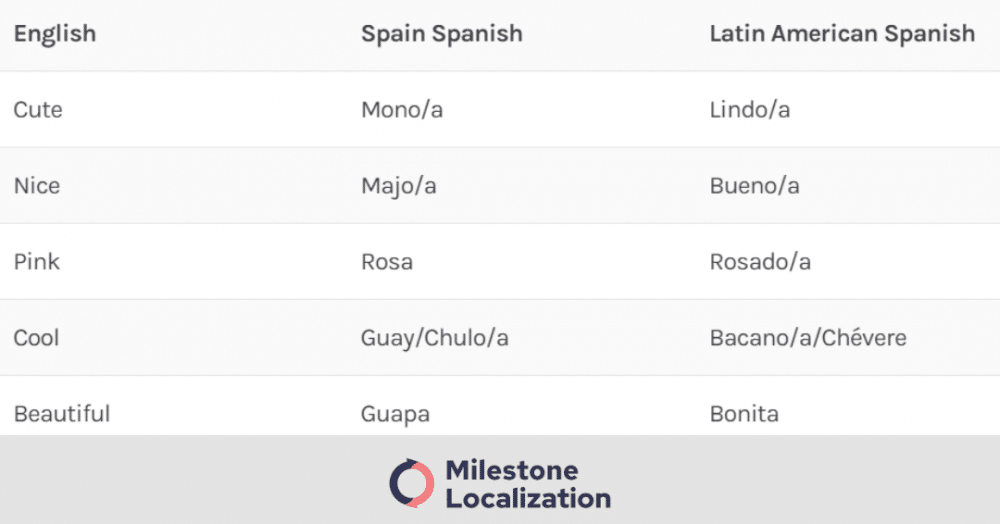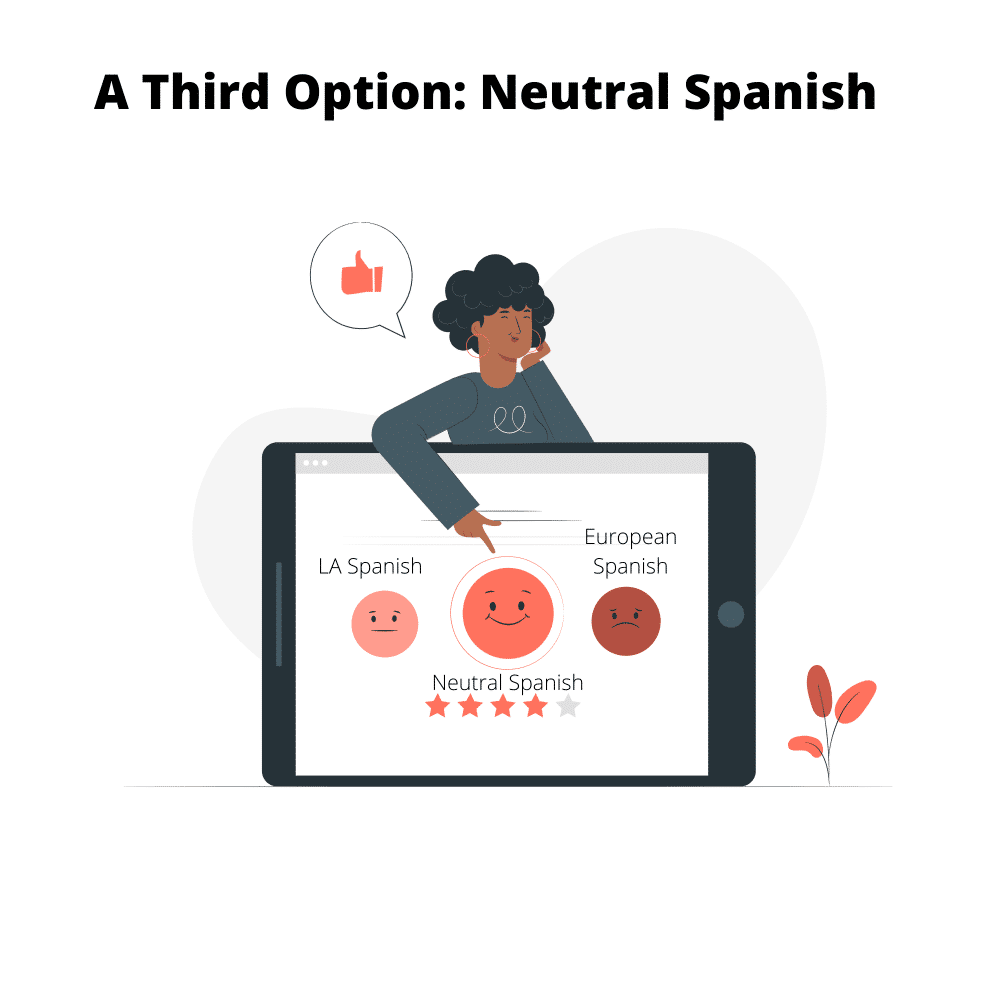Thinking of Spanish Localization for your website or app? Which dialect should you use? Latin American or European Spanish?
As suggested by recent demographic and economic factors, Spanish is a highly relevant language market today. According to data from Instituto Cervantes London, as of 2019, a whopping 580 million people speak Spanish in the world.
That accounts for roughly 7.5% of the planet’s population, making Spanish the most-spoken mother tongue in the world after Mandarin Chinese.
However, what makes this language stand out is not just its vast number of speakers, but the widespread distribution of its population. Spanish is the official language in 21 countries and represents most major Latin American populations, except for Brazil.
Spanish has become one of the most sought-for languages for website localization in the last decade.
It is precisely at this point where the Spanish localization dilemma occurs:
Should companies localize into European or Latin American Spanish?
This article will discuss the main differences between these two and how to choose the best option for your business.
Also Read: The Top Languages Spoken in California
Differences between LA and European Spanish
If you want to truly immerse your users into your content, you must first think about your audience’s language characteristics.
This is where differences between LA and European Spanish start to show.
We can summarize them into four main differences:
- Terminology: one of the biggest problems between these two variants is the vast differences in terminology usage.
For instance, a car translated as coche in Spain but as carro for the rest of Latin America.
Other examples include the words computer (ordenador in Spain and computadora in Latin America) and friend (colega in Spain and amigo in Latin America).
- Grammar: in general, European Spanish is more formal than Latin American Spanish.This primarily reflect the usage of the pronoun ‘you’ when referring to a group of people.Formal versions of you, like vosotros, are commonly used in Spain, while the informal version ustedes is more prevalent in Latin America.
The verb that are different in LA Spanish and European Spanish
The adjective that is different in LA Spanish and European Spanish
- Pronunciation: when dealing with video localization, companies need to be aware there are marked differences in pronunciation between LA and European Spanish. Mainly, people in Spain pronounce the letters C and Z as an English TH sound, while Latin Americans pronounce it as S.
Take cazando perdices (hunting partridges), for example:
– In Spain, it would sound like: ca[th]ando perdi[th]es
– In Latin America, it would sound like: ca[s]ando perdi[s]es
Fact is, many dialects within Latin America also have marked differences in pronunciation.
Argentinians and Uruguayans pronounce the Y and LL as an SH sound, while the rest of Spanish speakers pronounce it as a Y sound.
For instance, lluvia (rain) would sound like [sh]uvia in Argentina and [y]uvia everywhere else.
- Numbers: writing numbers can also vary depending on your location.In Mexico and most of Central America, numbers expressed like in the US, which uses a comma to separate thousands and a point for decimals.In South America and Spain, the exact opposite occurs.
For instance:
US, Mexico, and Central America: 1,000.30
South America and Spain: 1,000,30
A Third Choice
When it comes to localization, businesses reaching larger, international Spanish-speaking audiences could go for a third option.
Neutral Spanish, also known as standard Spanish, is a linguistic convention used for terms and phrases that any Spanish speaker could understand regardless of their geographical location.
When translators use neutral Spanish, they usually exclude idioms, slang, or any regionally specific terminology from their work.
Instead, they include generic terms that work both in Spain and Latin America.
For instance, in the previous ‘computer’ example, the neutral Spanish version could be equipo or PC.
Although it may seem like neutral Spanish could be the holy grail for Spanish localization, the truth is Spanish speakers don’t use those kinds of terms in everyday speech.
Therefore, reading neutral Spanish can sound dry and generic for some people.
In all fairness, many companies have successfully integrated neutral Spanish into their content.
For instance, news channel CNN en español, which broadcasts to most of Latin America, uses neutral Spanish for their articles.
However, if your business wants to convey a deep, heart felt, and emotional message, I’ve got news for you: neutral Spanish won’t resonate with your audience as much as a country-level localization.
Recommendations for Businesses
Now that all three options are clear, it’s time to figure out what’s best for you.
Here are some recommendations for businesses wanting to localize into Spanish:
- Target similar Spanish-speaking countries or regions to avoid doing country-level localization. For instance, there are not that many grammatical and vocabulary differences between Argentinian and Uruguayan Spanish.The same goes for Colombian and Venezuelan Spanish.
- If you need to translate high-volume or technical content, neutral Spanish will work best. This includes manuals, guides, contracts, medical records, or any low-risk content.
- Review your budget. Usually, starting companies cannot afford to do different localization for every country in Latin America. Neutral Spanish is, therefore, the best choice for beginners.
- For highly culture-specific materials, in-country trans creation is usually the best choice.
- If you end up using neutral Spanish for a multinational audience, make sure the content is proofread by a local to avoid potential misunderstandings or offences.
Conclusion
Businesses reaching for Latin America and Spain need to be very careful about what content they serve their customers.
Although profitable, providing content and services for Spanish speakers requires a deep level of cultural knowledge.
If detected, small subtleties in pronunciation or grammar can be devastating and cause failure to connect with your audience.
Depending on the type of content to localize, many options regarding the target Spanish dialect have been discussed.
Choosing either country-level localization, regional localization, or neutral Spanish is equally valid; however, each case must be studied individually to achieve the best results.
Need help translating or localizing your business/marketing content for Latin America or European countries?
Learn more about our Spanish translation services.
Have a file you want translated? Upload it here and we will get in touch.








